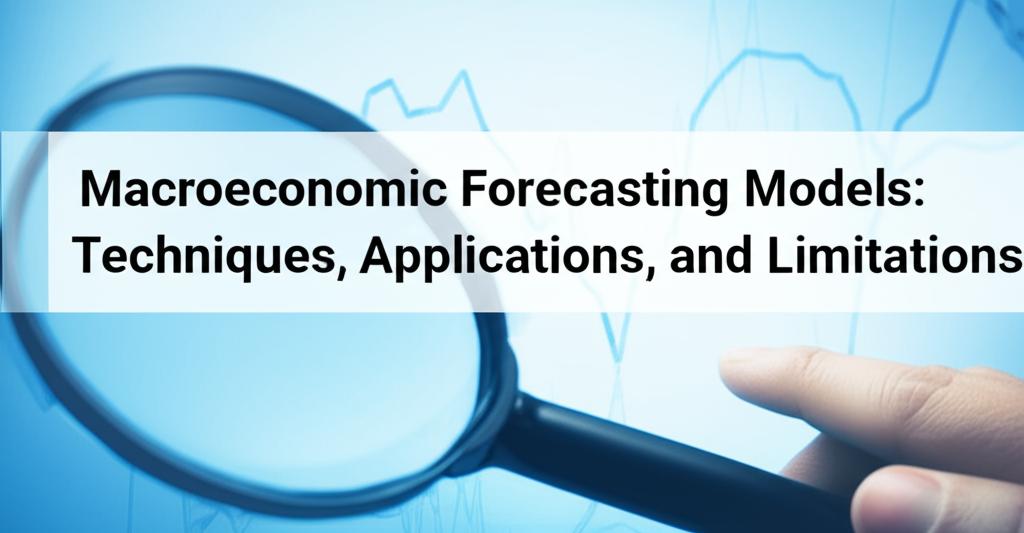Macroeconomic forecasting attempts to predict the future state of an economy, looking at indicators like GDP growth, inflation, unemployment, and interest rates. It's a crucial tool for governments, central banks, businesses, and investors to make informed decisions, though it's often described as more of an art than an exact science. While perfect prediction isn't feasible, forecasting provides a data-backed expectation for future economic trends, essential in navigating complex modern economies influenced by factors like technological change, geopolitical tensions, and climate concerns.
Techniques Used in Macroeconomic ForecastingForecasters employ a variety of methods, often using multiple approaches to build a comprehensive picture:
- Econometric Models: These models use economic theory combined with statistical techniques to map relationships between variables. They range from relatively simple regressions to large, complex systems.
Structural Models (e.g., DSGE, CGE): Attempt to model the underlying structure of the economy based on microeconomic foundations (household and firm behavior). They are useful for analyzing policy impacts and understanding economic mechanisms. Examples include models used by central banks like the IMF's GEM or NIESR's NiGEM.
Reduced-Form Models (e.g., VAR): Focus more on statistical relationships and forecasting performance without fully modeling deep structural parameters. Vector Autoregression (VAR) models, for instance, analyze interdependencies among multiple time series variables.
- Statistical Time Series Models: These models rely primarily on historical data patterns without necessarily incorporating deep economic theory.
ARIMA Models: Autoregressive Integrated Moving Average models are widely used for their robustness in handling time series data, capturing dependencies over time.
Exponential Smoothing: Effective for handling trends and seasonality, particularly in short-term forecasts.
Dynamic Factor Models (DFM): Used to extract common underlying trends from a large number of economic variables, particularly useful in real-time forecasting (nowcasting).
- Leading Economic Indicators (LEIs): This approach tracks variables known to change before the overall economy shifts direction (e.g., stock market returns, consumer confidence index, building permits, yield curve). It's intuitive but can sometimes provide false signals.
- Machine Learning (ML) and AI: Increasingly popular, these techniques leverage algorithms to identify complex patterns in vast datasets, including non-traditional sources like text or social media sentiment.
Neural Networks (e.g., LSTM): Effective for complex pattern recognition in time series data.
Random Forests, Boosting Algorithms, SVM: Handle large datasets and non-linear relationships.
Big Data Integration: Utilizing real-time indicators and high-frequency data for more timely forecasts ("nowcasting").
- Surveys and Consensus Forecasts: Gathering opinions from experts, consumers, or businesses can provide qualitative insights and expectations about future conditions. Consensus forecasts average predictions from various sources.
- Checklists: A more flexible approach where forecasters assess a range of potentially relevant data points and factors without being constrained by a formal model structure.
- Hybrid Models: Combining elements from different approaches (e.g., econometric theory with ML pattern recognition) aims to leverage the strengths of each.
Model selection depends on factors like data availability, the forecast horizon (short vs. long-term), the specific variables being predicted, and computational resources.
Applications of Macroeconomic ForecastsMacroeconomic forecasts are vital across various sectors:
- Government Policy: Governments use forecasts for budgeting (revenue and expenditure planning) and designing fiscal policy (taxation, spending) to stabilize the economy.
- Monetary Policy: Central banks heavily rely on forecasts (especially for inflation and GDP) to set interest rates and implement other monetary tools to manage economic growth and stability.
- Business Strategy: Companies use forecasts to guide decisions on investment, production levels, staffing, inventory management, and market entry or exit.
- Financial Markets: Investors and financial institutions use forecasts to inform investment strategies, manage risk exposure, and price assets.
- Scenario Planning and Risk Analysis: Models allow policymakers and businesses to simulate the potential impact of different economic shocks (e.g., oil price spikes, financial disruption) or policy choices.
Despite their importance, macroeconomic forecasts face significant limitations:
- Model Simplification: Economic models are necessarily simplifications of a highly complex reality. They often rely on assumptions (like linearity or rational behavior) that may not always hold true.
- Data Limitations: Forecasts depend on data that can be subject to lags, revisions, inaccuracies, or may not be available at the required frequency. Historical data may not capture new structural changes or unprecedented events.
- Unforeseen Shocks: Economies are vulnerable to unexpected events (pandemics, wars, technological disruptions, natural disasters, financial crises) that models struggle to predict in timing or magnitude.
- Behavioral Complexity: Human economic behavior is influenced by psychology, sentiment, and social factors ("animal spirits") that are difficult to quantify and incorporate accurately into models.
- Policy Uncertainty: Future government policies can change unpredictably due to political factors, altering the economic landscape in ways forecasts didn't assume.
- Structural Breaks: The underlying relationships in the economy can change over time (e.g., due to globalization, technological shifts, or demographic changes), making historical patterns less reliable guides to the future.
- Inherent Uncertainty: Forecasts are probabilistic, not deterministic. Introducing uncertainty bands or density forecasts can provide insight into the range of possible outcomes, but precision remains elusive.
- Potential Bias: Forecasts can sometimes be influenced by the forecaster's theoretical perspective or, in some institutional settings, by political considerations.
- Poor Track Record at Turning Points: Historically, forecasts have often struggled to accurately predict major economic turning points like recessions.
Macroeconomic forecasting is an indispensable yet challenging field. While techniques are constantly evolving, particularly with the integration of Big Data and machine learning promising enhanced accuracy and timeliness (especially for nowcasting), fundamental limitations remain. Models are stylized representations, data can be imperfect, and unexpected events frequently disrupt patterns. Acknowledging these limitations and often employing a multi-model approach, combined with expert judgment, is crucial for effectively using forecasts to navigate economic uncertainty and support sound decision-making.

